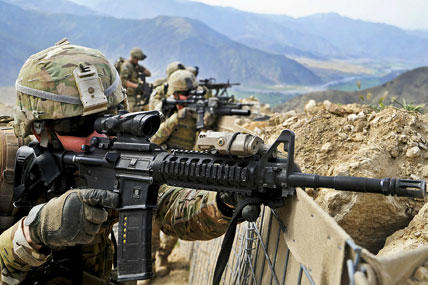The Army has ordered that soldiers may use only government-issued magazines with their M4 carbines, a move that effectively bans one of the most dependable and widely used commercial-made magazines on today’s battlefield.
The past decade of war has spawned a wave of innovation in the commercial soldier weapons and equipment market. As a result, trigger-pullers in the Army, Marines and various service special operations communities now go to war armed with commercially designed kit that’s been tested under the most extreme combat conditions.
Near the top of such advancements is the PMAG polymer M4 magazine, introduced by Magpul Industries Corp. in 2007. Its rugged design has made it as one of the top performers in the small-arms accessory arena, according to combat veterans who credit the PMAG with drastically improving the reliability of the M4.
Despite the success of the PMAG, Army officials from the TACOM Life Cycle Management Command issued a “safety of use message” in April that placed it, and all other polymer magazines, on an unauthorized list.
The message did not single out PMAGs, but instead authorizes only the use of Army-issued aluminum magazines. The message offers little explanation for the new policy except to state that “Units are only authorized to use the Army-authorized magazines listed in the technical manuals.” Nor does it say what Army units should now do with the millions of dollars’ worth of PMAGs they’ve purchased over the years.
Magpul officials have been reluctant to comment on the issue. Robert Vidrine, vice president of marketing and sales, said the company found out about TACOM’s message only after it was released to the field.
The decision has left combat troops puzzled, since the PMAG has an Army-approved national stock number, which allows units to order them through the Army supply system.
“This just follows a long line of the Army, and military in general, not listening to the troops about equipment and weaponry,” said one Army infantryman serving in Southwest Afghanistan, who asked not to be identified.
“The PMAG is a great product … lightweight and durable. I have seen numerous special ops teams from all services pass through here, and they all use PMAGs. Also, a large amount of Marine infantry here use PMAGS, including their Force Recon elements.”
TACOM officials said the message was issued because of “numerous reports that Army units are using unauthorized magazines,” TACOM spokesman Eric Emerton said in a written response to questions from Military.com. Emerton added that only “authorized NSNs have ever been included in the technical manuals. Just because an item has an NSN, does not mean the Army is an authorized user.”
This seems to be a complete policy reversal, since PMAGs are standard issue with the Army’s 75th Ranger Regiment and they have been routinely issued to infantry units before war-zone deployments.
Soldiers from B Troop, 3rd Squadron, 61st Cavalry Regiment, had been issued PMAGs before deploying to Afghanistan in 2009. On Oct. 3 of that year, they fought off a bold enemy attack on Combat Outpost Keating that lasted for more than six hours and left eight Americans dead. Some soldiers fired up to 40 PMAGs from their M4s without a single stoppage.
Militay.com asked TACOM officials if the Army had discovered any problems with PMAGs that would warrant the ban on their use. TACOM officials would not answer the question and instead passed it off to Program Executive Office Soldier on Thursday evening before the four-day Memorial Day weekend.
TACOM’s message authorizes soldiers to use the Army’s improved magazine, which PEO Soldier developed after the M4 finished last against three other carbines in a 2007 reliability test. The “dust test” revealed that 27 percent of the M4’s stoppages were magazine related.
The improved magazine uses a redesigned “follower,” the part that sits on the magazine’s internal spring and feeds the rounds into the M4’s upper receiver. The new tan-colored follower features an extended rear leg and modified bullet protrusion for improved round stacking and orientation. The self-leveling/anti-tilt follower reduces the risk of magazine-related stoppages by more than 50 percent compared to the older magazine variants, PEO Soldier officials maintain. Soldiers are also authorized to use Army magazines with the older, green follower until they are all replaced, the message states.
Military.com asked the Army if the improved magazine can outperform the PMAG, but a response wasn’t received by press time.
The same infantryman serving in Southwest Afghanistan had this to say about the new and improved magazine:
“Like any magazine, they work great when they are brand new and haven’t been drug through the dirt and mud. I haven’t noticed much of a difference between these tan followers and the older green ones. After some time training up for the 'Stan, the same issues started to occur: double feeds, rounds not feeding correctly so on and so on. While it seems to occur about half as often, it’s still not a great solution.
“The magazines still get bent at the opening and are still prone to getting crushed in the middle. I haven’t seen any issues like this with the PMAG due to the polymer casing. I have seen an empty PMAG get run over by a MaxPro [vehicle] and operated flawlessly later that week when we tested it at the range. Last time I saw this happen to a standard issue magazine, it was scrap metal after that.”






























